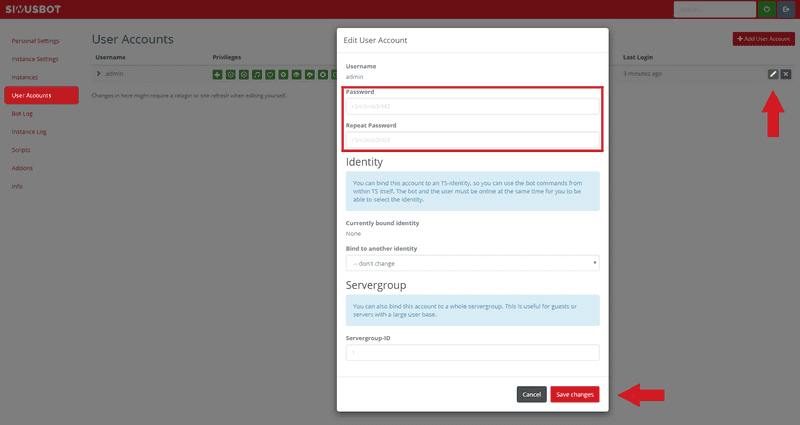Introduction
This article describes the installation and configuration of a SinusBot program with two instances, you can use one SinusBot per instance. It is also possible to run multiple SinusBot programs in parallel to use several SinusBots.
SinusBot is a program that allows you to listen to your favorite music together with your friends on Teamspeak.
Requirements
- A 64-bit compatible OS
- Ubuntu 14.04+/ Debian 8+
- A CX23 Hetzner CloudServer or better
- Teamspeak
Step 1 - Preparations
Before we get started your CloudServer should be updated.
apt-get update && apt-get -y upgradeSinusBot needs several dependencies which have to be installed urgently!
apt-get install -y x11vnc xvfb libxcursor1 ca-certificates bzip2 libnss3 libegl1-mesa x11-xkb-utils libasound2 libglib2.0-0 libgl1 libnspr4 libfontconfig1 libxi6 libxcursor1 libxcomposite1 libasound2 libxtst6Update the certificates by ca-certificates.
update-ca-certificatesFor the installation a user sinusbot must be created.
useradd -m -s /bin/false sinusbotNow the installation directory must be created.
mkdir /opt/sinusbot && chown -R sinusbot:sinusbot /opt/sinusbotStep 2 - Installation
For the installation we have to switch to the created sinusbot user.
su --shell /bin/bash sinusbotChange to the sinusbot installation directory.
cd /opt/sinusbotNow we need the newest SinusBot version which we unpack directly.
curl https://www.sinusbot.com/dl/sinusbot.current.tar.bz2 | tar xjf -To make SinusBot work, a Teamspeak client must be installed in the installation directory and the permissions have to be adjusted.
wget http://dl.4players.de/ts/releases/3.2.3/TeamSpeak3-Client-linux_amd64-3.2.3.run && chmod 0755 TeamSpeak3-Client-linux_amd64-3.2.3.runNow the Teamspeak Client has to be unpacked.
./TeamSpeak3-Client-linux_amd64-3.2.3.runIn the unpacking process press Enter + q + y + Enter in succession!
Step 3 - Configuration
After the Teamspeak was unpacked. Now the config.ini.dist must be copied and edited.
cp config.ini.dist config.ini && nano config.iniIn the config.ini the following must be replaced:
TS3Path = "/opt/ts3soundboard/TeamSpeak3-Client-linux_amd64/ts3client_linux_amd64"
Replace with:
TS3Path = "/opt/sinusbot/TeamSpeak3-Client-linux_amd64/ts3client_linux_amd64"
To save Ctrl+O + Enter and to exit press Ctrl+X!
In the Teamspeak installation directory I recommend to delete an unneeded library, otherwise you might have problems with Teamspeak.
rm TeamSpeak3-Client-linux_amd64/xcbglintegrations/libqxcb-glx-integration.soNow the folder structure in the Teamspeak installation directory has to be adapted and an important plugin has to be copied.
mkdir TeamSpeak3-Client-linux_amd64/plugins && cp plugin/libsoundbot_plugin.so TeamSpeak3-Client-linux_amd64/plugins/ && chmod 755 sinusbotNow SinusBot has to be started for the first time.
./sinusbotIn the CLI SinusBot generates access data which you can use to access the SinusBot webinterface under: yourserverip:8087
After logging in, the webinterface appears.
I recommend to change the password generated by SinusBot with your own secure password directly at the beginning!
Settings > User Account > Edit (pen)
Press Save changes to change your password.
If you have changed your password we can connect your SinusBot to a Teamspeak server.
Settings > Instance Settings
- Nickname: Display name in Teamspeak
- Hostname/IP: Address of the Teamspeak server
- Port: By default to 9987
Press Save changes to save your settings.
After saving, the SinusBot can be switched on by pressing the orange button (next to the search).
In the SinusBot webinterface a second instance can be added.
Settings > Instances > Add Instance
With select one of the instances can be selected and configured under Settings > Instance Settings.
Notice: If two SinusBot instances are not enough you have the possibility to run several SinusBot programs in parallel, just follow the steps above for each installation.
mkdir /opt/sinusbot1 && chown -R sinusbot:sinusbot /opt/sinusbot1 mkdir /opt/sinusbot2 && chown -R sinusbot:sinusbot /opt/sinusbot2 mkdir /opt/sinusbot3 && chown -R sinusbot:sinusbot /opt/sinusbot3 etc...
To start SinusBot easily a startscript can be used. This must be done as root user! So just use the exit command to leave the sinusbot user.
curl -o /lib/systemd/system/sinusbot.service https://raw.githubusercontent.com/SinusBot/linux-startscript/master/sinusbot.service && nano /lib/systemd/system/sinusbot.serviceNow you have to change some entries in the sinusbot.service.
User=sinusbot #Created user
ExecStart=/opt/sinusbot/sinusbot #Path to the SinusBot binary
WorkingDirectory=/opt/sinusbot #Path to the SinusBot directoryTo save Ctrl+O + Enter and to exit press Ctrl+X!
To apply the changes to the sinusbot.service, systemctl must be reloaded.
systemctl daemon-reload(Optional) SinusBot can also be started automatically after a restart.
systemctl enable sinusbotOur SinusBot can now be started by using systemctl.
systemctl start sinusbotNotice: If you have multiple SinusBot installations and want to use the
startscript, consider creating multiple startscripts and changing the path for each installation./lib/systemd/system/sinusbot1.service https://... /lib/systemd/system/sinusbot2.service https://... /lib/systemd/system/sinusbot3.service https://...sinusbot1.service User=sinusbot #Created user ExecStart=/opt/sinusbot1/sinusbot #Path to the SinusBot binary WorkingDirectory=/opt/sinusbot1 #Path to the SinusBot directorysinusbot2.service User=sinusbot #Created user ExecStart=/opt/sinusbot2/sinusbot #Path to the SinusBot binary WorkingDirectory=/opt/sinusbot2 #Path to the SinusBot directory etc...
Conclusion
If you have followed the tutorial so far, you now have your own SinusBot program with two instances and can use up to two SinusBots on two different Teamspeak servers. Optionally you can let SinusBot start automatically after each restart.




